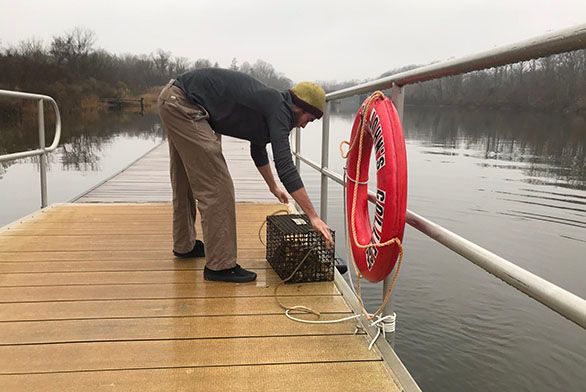Hodson Boathouse Brings Oyster Gardening to St. John’s
January 20, 2020 | By Les Poling

St. John’s College in Annapolis has long cherished its relationship with the Chesapeake Bay. Located on the banks of College Creek, with easy access to the Severn River and surrounding watershed, St. John’s has a rich maritime history, with the Hodson Boathouse serving as home base for Johnnies who sail, row crew, or simply love spending time on the water.
Now, that relationship has evolved. Since September of 2019, St. John’s staff and student boathouse stewards have been growing oysters off the Hodson Boathouse docks, joining in a wider community effort to restore the bay and create a flourishing natural environment for generations to come.
At one point in time, the Chesapeake Bay was one of the most pristine estuaries in America, with more than 400 miles of crystal clear water and thriving natural habitats. That was prior to European settlement, mass population growth, and overconsumption of resources, among other detriments, leading to a massive decline in the bay’s health. Nitrogen pollution from storm water and agricultural runoff is the most devastating problem, according to the Chesapeake Bay Foundation (CBF), a nonprofit devoted to the restoration and protection of the bay, and the consequences of climate change pose an existential threat. But nearly as important to the bay is its oyster population.
Oysters function as natural water filters, improving water quality by consuming free-swimming algae like phytoplankton. The oyster reefs that formed in the bay—the result of generation-spanning settlement and growth—provide structured habitats for various species of fish and crab. According to some estimations, the regional oyster population was once so large it defined area river channels; it could reportedly filter all the water in the Chesapeake Bay in just one week. But after decades of over-harvesting, water pollution, disease, and plummeting salinity, the CBF reports that the number of oysters in the bay is less than one percent of its former heights.
That’s where the Hodson Boathouse docks come into play.
In August of 2019, Mike Waters joined the St. John’s College staff as Hodson Boathouse manager. Almost immediately, he says, it was suggested to him that he look into using the boathouse’s prime location to take part in the CBF’s oyster gardening program—a community outreach project designed to increase oyster population growth. Essentially, the CBF raises baby oysters (spat) and trains community members in oyster cage-building and effective gardening. Then, participants bring the microscopic baby oysters to their new waterside homes, where, with proper care, they can grow healthy and strong over the next nine months. At the end of the term, the oysters are returned to the CBF and placed in sanctuaries: designated no-harvesting zones where the oysters (and, as a result, the bay) can thrive.
“The survival rate is much higher if we can take them for the first nine months of life and get them up to an inch or two [in size],” Waters says. “It’s basically an environmental outreach for us.”
Waters spent an autumn Saturday in training, building four oyster cages of his own—“you can tell which one I did first,” he says—and filling them with spat. He brought them back to the Hodson Boathouse, suspending them off the boathouse docks to grow peacefully beneath the surface of College Creek. Since then, his team of student boathouse stewards have carefully tended to the oysters’ wellbeing. “When the weather is warm—[oysters can’t survive air temperatures below freezing]—we’ll pull the cages up once a week and shake them out,” Waters says. “We shake the cages to keep the oysters from growing into the wire of the cages and to dislodge sediment and algae buildup. Oysters live on nutrients suspended in the water, and maintaining good water flow helps them grow.” The stewards then hoist the cages onto the dock and wash them, a precautionary measure meant to protect the oysters from a parasitic worm that can’t tolerate fresh water. “When you pull the oysters out, they close up tight, keeping a little bay water inside their shells,” Waters says. “They’re perfectly safe for a few hours.”
In the months since the St. John’s oyster gardening endeavor began, the boathouse stewards have tracked noticeable oyster growth—an encouraging sign, both for the health of these four cages and the rest of the bay. Around May or June, Waters will return the nine-month-old oysters to the CBF, which in turn brings the oysters to their sanctuaries. He’ll then head back to the Hodson Boathouse, another four cages of spat in tow, ready to start the process again.
“I think it’s a great program,” Waters says. “I’d like to do more of it.”
While it was Waters who completed the CBF training and built the cages, the student boathouse stewards play a central role in helping the oysters grow to fruition. In a way, it’s a seamless complement to the St. John’s Program; an approach to an urgent, contemporary problem that relies on studying the natural world and asking constructive questions. As Waters puts it: “We’re on the edge of this major [environmental] change. So, what can we do?”
And hopefully, the St. John’s contribution will be part of a collective push to restore one of the country’s environmental crown jewels.
“The notion is being good stewards of the planet,” Waters says. “We’d like to bring the bay back as best we can.”

